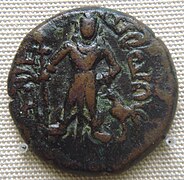Yaudheya


Yaudheya or Yaudheya Gana was an ancient confederation that occupied the areas between the Indus river and the Ganges river. The word Yaudheya is a derivative of the word yuddha or from yodha meaning warriors.[1][2] They principally were kshatriya renown for their skills in warfare, as inscribed in the Junagadh rock inscription of Rudradaman.
They are mentioned in Pāṇini's Ashtadhyayi and Ganapatha. There are other references to them namely in the Mahabharata, Mahamayuri, Brihatsamhita, Puranas, Chandravyakarana and Kashika. As references are spanned from writings of early period to the medieval period, the chronology of Yaudheyas perhaps spans from as early as 500 BCE till 1200 CE. They were in zenith of their power from about 200 BCE to 400 CE.
Yaudheyas were the rulers of South-Eastern Punjab, Haryana and north Rajasthan. Varahamihira in his Brihatsamhita (XIV.28 and XVI.22) placed them in the northern division of India.
Puranic reference
Puranas (e.g. Brahmanda, Vayu, Brahma and Harivamsha) described Yaudheyas as the descendants of Usinara and Nrigu.[3]
Literary and epigraphical references
The earliest references of the existence of the Yaudheyas is in Pāṇini's Ashtadhyayi (V.3.116-17 and IV.1.178) of (c.500 BCE) and the Ganapatha. In his works the Yaudheyas are mentioned as ayudha-jivin sanghas i.e., a community living by the profession of arms.[1]
Interaction with the Indo-Greeks (2nd-1st century BCE)
Slightly northwest of Mathura in the region of Haryana, numerous coins of the Indo-Greeks have been found together with those of the Yaudheyas, suggesting periods of overlapping or successive rule. Such coins were found in the ancient villages of Khokrakot (modern Rohtak), and Naurangabad, were Indo-Greek coin molds were also found, suggesting Indo-Greek occupation of Haryana in the 2nd-1st centuries BCE.[4][5][6]

After that period, the Yaudheyas started to mint their own coins in a style highly reminiscent of Indo-Greek coinage, and the Arjunayanas and Yaudheyas mention military victories on their coins ("Victory of the Arjunayanas", "Victory of the Yaudheyas"). It is thought the Yaudheyas had become an independent kingdom at that point.[7]
Defeat against the Western Satraps (2nd century CE)
Later, the Junagadh rock inscription (c. 150 CE) of Rudradaman I[8] acknowledged the military might of the Yaudheyas "who would not submit because they were proud of their title "heroes among the Kshatriyas"", although the inscription claims that they were ultimately vanquished by Rudradaman.[9][10]
Rudradaman (...) who by force destroyed the Yaudheyas who were loath to submit, rendered proud as they were by having manifested their' title of' heroes among all Kshatriyas.
— Junagadh rock inscription[11]
Kushan Empire

It is thought that the Kushans then became suzerains of the Yaudheyas when they endeavoured to hold the Mathura area.[12] An indication is the fact that the Kushan ruler Huvishka featured Maaseno on his coins, the Kushan incarnation of the Hindu god Karttikeya, or Skanda, whose epithet was "Mahasena". This god being particularly important to the Yaudheyas, it may have been incorporated into Kushan coinage when the Kushans expanded into Yaudheya territory.[13][12]
Feudatories of the Gupta Empire

The name of the Yaudheyas is later mentioned in the Allahabad pillar inscription of the Gupta Empire ruler Samudragupta, as submitting to his rule.[14]
(Lines 22–23) (Samudragupta, whose) formidable rule was propitiated with the payment of all tributes, execution of orders and visits (to his court) for obeisance by such frontier rulers as those of Samataṭa, Ḍavāka, Kāmarūpa, Nēpāla, and Kartṛipura, and, by the Mālavas, Ārjunāyanas, Yaudhēyas, Mādrakas, Ābhīras, Prārjunas, Sanakānīkas, Kākas, Kharaparikas and other (tribes)."
Numismatic evidences
-
Six-headed Karttikeya on a Yaudheya coin. British Museum.
-
Karttikeya shrine with antelope. Yaudheya, Punjab, 2nd century CE
-
Coin of the Yaudheyas. Circa 3rd-4th Century CE.
Their territory included on the west–Sutlej, Dipalpur, Satgarha, Ajundhan, Kahror, Multan, on the east - Bhatner, Abohar, Sirsa, Hansi, Panipat and Sonipat and on the north - Kangra. These were listed based on the assumptions of coin finds. Even Haryana and Panjab were included in the territory they might have ruled.
The existence of a powerful clan known as Yaudheyas has come to light mainly from their coins and coin-moulds found in large number in this area.[15]
See also
- Ahibaran, the most prominent Yaudheya king
References
Footnotes
- ^ a b “Yaudheyas.” Ancient Communities of the Himalaya, by Dinesh Prasad. Saklani, Indus Pub. Co., 1998, pp. 112–115.
- ^ Smith, V. (1897). Art. XXIX.—The Conquests of Samudra Gupta. Journal of the Royal Asiatic Society, 29(4), 859-910. doi:10.1017/S0035869X0002503X
- ^ Pargiter, F.E. Ancient Indian Historical Tradition Motilal Banarasidass, Delhi, 1972 pp.109
- ^ "Coin-moulds of the Indo-Greeks have also been recovered from Ghuram and Naurangabad." Punjab History Conference, Punjabi University, 1990, Proceedings, Volume 23, p.45
- ^ History and Historians in Ancient India, Dilip Kumar Ganguly, Abhinav Publications, 1984 p.108
- ^ Encyclopaedia of Tourism Resources in India, Volume 1, Manohar Sajnani, Gyan Publishing House, 2001 p.93
- ^ "Most of the people east of the Ravi already noticed as within Menander's empire -Audumbaras, Trigartas, Kunindas, Yaudheyas, Arjunayanas- began to coins in the first century BC, which means that they had become independent kingdoms or republics.", Tarn, The Greeks in Bactria and India p.324.
- ^ Junagadh Rock Inscription of Rudradaman I, accessed on 23 March 2007.
- ^ Rosenfield, "The dynastic art of the Kushans", p132
- ^ Rapson, "A catalogue of the Indian coins in the British Museum", p.lx
- ^ Source
- ^ a b Indian Sculpture: Circa 500 B.C.-A.D. 700, Los Angeles County Museum of Art, Pratapaditya Pal, University of California Press, 1986, p.78 [1]
- ^ Classical Numismatics Group
- ^ a b Corpus Inscriptionum Indicarum Vol 3 p251
- ^ Allan, John A Catalogue of the Indian Coins in the British Museum (Ancient India), London, 1936, Pl. XXXIX.22
Further reading
- Dasgupta, K.K. A Tribal History of Ancient India: A Numismatic Approach, Calcutta, 1974.
- Lahiri, Bela Indigenous States of Northern India (Circa 200 B.C. - 320 A.D.), University of Calcutta, 1974.




